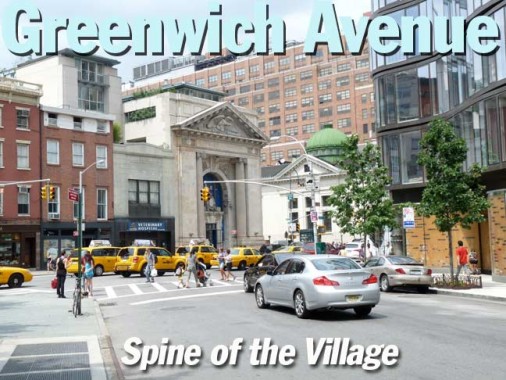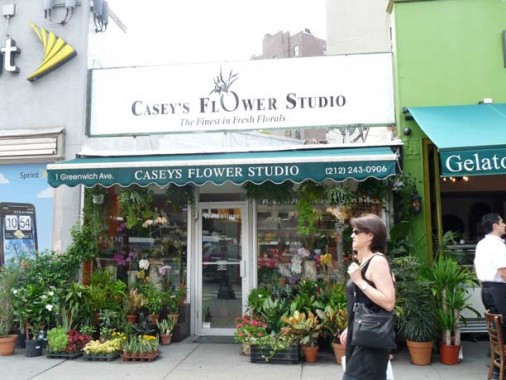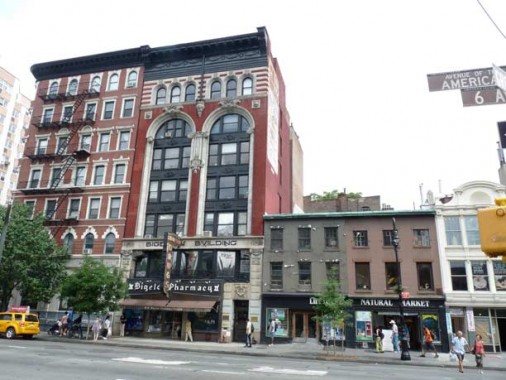Two major streets named Greenwich pass through the lower west side neighborhood they are named for, Greenwich Village. One, Greenwich Street, begins at the Brooklyn Battery Tunnel and Edgar Street (Manhattan’s shortest through street) and runs north to Gansevoort and 9th Avenue in the Meatpacking, interrupted by the World Trade Center site between Liberty and Barclay. Greenwich Street’s two “halves” are scheduled to be connected by a new section to be built within the next few years, as this is written in 2012.
The other, which FNY is concentrating on today, is much shorter–Greenwich Avenue runs for only a few blocks from 6th Avenue and West 8th northwest to 8th Avenue and West 13th at Jackson Square.
The term “Greenwich Village” is actually redundant: in old English, wych, wich or wyck all mean “village” and have origins in the Latin vicus. So, when you say “Greenwich Village” you’re saying “Green Village Village.” According to Henry Moscow in The Street Book, the term first appears in city records in 1713, long before any of the streets were laid out. However: in Greenwich Village and How It Got That Way, Terry Miller gives an earlier date: in 1696 a Dutch settler named Yellis, or Giles, Mandeville named a pasture near his settlement at today’s Gansevoort Street after a town near where he had lived — in Breukelen — called Greenwich, or Dutch Grenwyck.
Before the days of Yellis Mandeville, the region was occupied by the Lenape Indians, who bestowed it the name Sappokanican, and then the Dutch, who called it Bossen Bouwerie, or “farm in the woods.”
In the summer of 2011, I walked the whole of Greenwich Avenue, all 12 blocks. I’ll have more on its history a little later but if you look at the map, you notice it’s the dividing line between two competing street grids: the Greenwich Village grid, roughly oriented northeast and southwest, and the 1811 Commissioners Plan grid, surveyed by John Randel Jr. and his team, that laid out the island in a rough (as in not exact) east-west-north-south orientation from North (Houston) Street north to 155th.
#1 Greenwich Street, just west of 6th, is Casey’s Flower Studio. This is the original site of Balducci’s, where two immigrant brothers from Italy, Luigi and Mario, sold bananas–the store later became a Village gourmet food institution before it abandoned its two remaining Manhattan shops in 2009. Balducci’s still has an online presence and stores in Connecticut (in, er, Greenwich), as well as Scarsdale, Bethesda, MD and two locations in Virginia.
In 1838, when Martin Van Buren was President, a small apothecary opened on Sixth Avenue just north of Clinton Place (now West 8th Street), and after it had changed hands a couple of times and moved two doors uptown, Clarence Otis Bigelow had established his “chemist’s”. The present building dates to 1902; the pharmacy still occasionally displays a 1905 ledger containing regular customer Mark Twain‘s name. Note the gas jets on the electric chandeliers: they still work, and in the 1965 and 1977 blackouts, they were turned on; Bigelow’s remained open.
Directly to the left, the corner building on 6th Avenue and West 9th was home to Trude Heller’s from about 1960-1982. For awhile, the house band was Barry and the Remains, a Boston group who never had any real hits but appeared on the Ed Sullivan Show and opened for the Beatles on a 1965 USA tour. In its long history Heller’s also hosted Goldie (Genya Ravan) and the Gingerbreads and the young Beastie Boys.
NW corner, Greenwich Avenue and Christopher Street. 1930s 14-story Tudor-esque high rise with casement windows that look out upon…
…The Jefferson Market Garden, in the rear of the wildly Gothic Jefferson Market Library, an 1877 tower formerly a courthouse/prison, now home to a library. In mid-2011 the tower was enshrouded in scaffolding as the exterior was being touched up. The Garden stands on the site of a women’s prison that stood alongside the courthouse and men’s prison.
The Women’s House of Detention closed in 1973 and the following year, the Garden replaced it:
The Board of Estimate transferred the site to Parks in 1974, and the Jefferson Market Garden Committee, Inc., composed of Village neighborhood associations and homeowners, was entrusted with its care. Landscape architect Pamela Berdan originally designed the garden in the spirit of Frederick Law Olmsted, who co-designed Central and Prospect Parks with Calvert Vaux. The garden was planted with 10 Star and Saucer Magnolia trees, 7 Yoshino Cherry trees, 2 American Yellowwoods, 7 Thornless Honeylocusts, 10 Crabapple trees, 70 fairy hedge roses around the lawn, 60 pycarantha, and 56 holly bushes in clusters. Volunteers have since planted tulips, daffodils, and crocuses in the garden. NYC Parks
Saint Germain Apartments, NW corner Greenwich Avenue and West 10th Street, another high rise, this one built in 1962. This building always reminds me of Lou Reed’s song from 1972’s Transformer, “I’m So Free,” which contains the lines:
“Oh please, Saint Germaine
I have come this way
Do you remember the shape I was in
I had horns and fins”
What was Reed referring to? A couple of sources say it was the Count of Saint-Germaine (1712-1784) a prominent composer, mystic, occultist and what would, by the 1960s, be referred to as a counterculturist. Perhaps, St-Germain liqueur. Maybe the actual Saint Germaine, a 5th-Century Gallic bishop. Or, perhaps, Reed was referring to this building, since he was a NYC resident beginning in 1964 after graduating from Syracuse.
A look east on W. 10th toward the Jefferson Market Courthouse, which was enshrouded in construction netting.
FDNY Squad Company 18 (Originally Engine 18) at 132 West 10th near Greenwich Avenue was founded in 1865, with this 3-story firehouse built in 1891. The building to the immediate left, at #130, in 1941-42 was known as the Almanac House, where Woody Guthrie and Pete Seeger held hootenannies when they were in the Almanac Singers, a pro-labor, anti-fascist folk group. The Almanacs were so called because Lee Hays (who later had pop success with Seeger in The Weavers) said that back home in Arkansas they had two books in the house, the Bible for the next life and an almanac for this one.
A restaurant will occupy the former space of Village Paper; until it was burned out it had been at the NE corner of Greenwich Avenue and West 10th since the mid-1970s.
Old-fashioned signs mark Joseph Hanna Leather Goods at #33 Greenwich Avenue.
44-46 Greenwich Avenue. 44 is home to one of NYC’s dwindling indie bookstores, Partners & Crime, which specializes in mystery, founded in 1994 but seems like it has been there longer than that.
NW corner of Greenwich Avenue and Perry Street. Just after I got out of school I frequented a tavern on the ground floor here called McGowan’s. We will see more roughly rhomboid buildings like this, as Greenwich Avenue makes sharp angles with its intersecting streets.
There must be a reason behind the scalloped roofline on #54-58. Judging by the window designs, #58 was once separate from #54-56. Greenwich Avenue, with exceptions here and there, must look much the same as it did in 1910, with not a whole lot of building teardowns and replacements.
#60-66 Greenwich, which, aside from some paint jobs over the years and changing storefronts, have remained largely unchanged for decades right down to the corbel, lintel and window treatments.
Mulry Square: Tiles for Smiles
Mulry Square, one of the Village’s busiest intersections, was created in the early 1910s when 7th Avenue was plunged south from its original source at Greenwich Avenue and West 11th south to connect with Varick Street. This was done when a cut and cover trench for a southern extension of the IRT Subway was being built. 7th Avenue South was gouged through the Village in Moses-ian fashion, creating several new spiderwebs of intersections.
Since shortly after the massacre of 9/11/01 Mulry Square, the southwest corner of 7th Avenue South and Greenwich Avenues, a lot bounded by a chain link fence has been the site for hundreds of colorful painted tiles offering remembrance and hope.
The empty hulk of St. Vincent’s Catholic Hospital stands at the northeast corner of 7th Avenue and Greenwich Avenue. The hospital, which was more than $1 billion in debt, closed on April 30, 2010. The medical center had been founded by the order of the Sisters of Charity in 1849 and named for its founder, Saint Vincent de Paul. The now-empty facility replaced the old Elizabeth Bayley Seton Building in 1987. It was one of the first medical facilities in the city with a treatment center specifically for HIV and AIDS patients, as well as a Chinese -speaking inpatient unit to serve nearby Chinatown.
It has treated victims of calamities: the cholera epidemic of 1849, the sinking of the Titanic in 1912, the 9/11 attack and, just last year, the Hudson River landing of US Airways Flight 1549. The poet Edna St. Vincent Millay got her middle name from the hospital, where her uncle’s life was saved in 1892 after he was accidentally locked in the hold of a ship for several days without food or water. —The Decline of St. Vincent’s Hospital [New York Times]
FNY normally doesn’t do endorsements but I have always enjoyed Two Boots’ spin on the pizza experience: add Cajun spices and other elements unthought-of in Italy. Two Boots’ sit-down restaurants on Avenue A in the East Village and in Park Slope are usually full of happy, squealing kids. But I have never minded, which is something for me. NW corner of West 11th and Greenwich.
At Bank Street, Artepasta (whose remaining neon sign looks like ARTERASTA) has apparently closed permanently, though it had been there for over 30 years.
A look east on West 12th at the utterly unique Edward and Theresa O’Toole Medical Services Building (formerly National Maritime Union of America AFL-CIO Building) constructed in 1964. The early 1960s was an era of whiz-bang architecture, with some wildly divergent forms ushered in by Frank Lloyd Wright’s Guggenheim Museum on 5th Avenue and East 89th in 1959 and continuing through the World’s Fair era of 1965. In NYC, new buildings have been fairly tame and bland ever since.
It was turned its present shade of white in 1977. Before it closed, St. Vincent’s had permission to raze it and build a hospital annex.
West 12th joins a number of streets in Greenwich Village that have been permitted to retain their Belgian block pavement, at least for now. Looking toward another of Greenwich Avenue’s distinctive apartment buildings.
At W. 12th Street: Equinox Fitness, which isn’t bad as far as 21st Century building design goes, replaced the Art Greenwich Twin, which had been there from a few years east or west of 1940 through 2000. It was a theater I had been in exactly once, on a date in 1982, though I forget what we saw there.
Monument Lane
Formerly the Day-O Tavern (with a big blue and white neon awning sign seen here on my West 12th Street ForgottenSlice page) the new restaurant Monument Lane pays tribute to a very old name for Greenwich Avenue…
Turning back the clock to the 1760s…
Greenwich Avenue happens to be one of the oldest existing roads on Manhattan Island. Originally it was part of an Indian trail in the village of Sappokanican that ran southeast and east to about where Cooper Square is today. Another piece of that trail still existing today is Astor Place that runs between Broadway and 3rd Avenue.
Under Dutch rule the road was called Strand Road but by the colonial era the British had made it a military pathway as it ran through the estate of Admiral Peter Warren, the commander of British naval forces during the Revolution. He had acquired several hundred acres of property in the Village in the 1740s.
After 1762, the road was known as Monument Lane or Road to the Obelisk. In 1762, at the spot where Greenwich Avenue meets 8th Avenue today, the British erected a monument to British Major General James Wolfe (1727-1759) who had died in the Battle of Quebec in the Seven Years’ War, but by 1773, before American independence was declared, the monument had disappeared from local maps.
The theory had been advanced that the English soldiers took away with them this memorial of their gallant countrymen — fearing that harm may come to it in a rebellious land. But an obelisk is not a handy thing for an army to carry around with it …[t]herefore, I think that if it had really been put aboard ship, somebody here would have chronicled the queer fact: and that had it been landed in another country, news as to its whereabouts would have come to New York in the century and more that has passed since it disappeared. Thomas A. Janvier, In Old New York, 1894
1778 map showing the Warren property and what had been Monument Lane (circled). After the Revolutionary War ended and American independence secured, Monument Lane became Greenwich Lane.
In the first decades of the 19th Century, Greenwich Village’s layout took shape. Greenwich Lane determined the angle of the north-south streets that roughly paralleled it, with the Village’s east-west streets meeting it at a rough right angle. With a few name changes here and there this is still the Greenwich Village street layout, with 7th Avenue South joining the party in 1912.
This Dripps plate from 1867 shows Greenwich Avenue in its final form. Note that present-day landmarks like Jackson Square and St. Vincent’s Hospital are in place on the map.
More of Greenwich Avenue’s surprisingly well-preserved brick houses, #96-100.
Some nifty casement windows at the slight angle of Greenwich Avenue and Jane Street. There are a number of streets in Manhattan named for women (Catherine Street, Ann Street) but Jane Street is not one of them. A Mr. Jaynes owned property in the area around 1800–after that, the parcel was sold to William Bayard, a friend of Alexander Hamilton. In 1804 Hamilton was taken there after his fatal duel with Aaron Burr in Weehawken, where he passed.
Although Greenwich Village and Greenwich Avenue’s name is not British in origin, it sounds like it, and it has attracted a number of businesses with British-sounding names, such as Elephant and castle (a square in London) Tea and Sympathy (British play and film) carry On Tea and Sympathy (the Carry On series was a long-running British comedy film series) and the fish and chips shop A Salt & Battery.
Sharp-angled building where East 13th turns east at Greenwich Avenue. I always wanted one of those narrow rooms with one window.
North of 13th Street: Substation for 8th Avenue Subway, built 1932-1933 at the height of the Art Moderne era that de-emphasized ornamentation in favor of a bolder, more straightforward approach. There was decoration, but not a whole lot. The brickwork, using just a few contrasting hues, is attractive and the lettering here is exactly the same lettering used in IND station name plates and directional signs. Wish I knew the font name.
A substation is a part of an electrical generation, transmission, and distribution system. Substations transform voltage from high to low, or the reverse, or perform any of several other important functions. Electric power may flow through several substations between generating plant and consumer, and its voltage may change in several steps. wikipedia
Located on the triangle between 8th and Greenwich Avenues and Horatio Street, Jackson Square has officially been a public park since 1872, though it appears as a “square” on maps prior to that. It’s widely thought that the square is named for its most obvious honoree, President Andrew Jackson ( 1767-1845) since “Old Hickory” had been a hero in Tammany Hall circles. However, Mozart Hall, a faction that had split off from Tammany, met in a building called Jackson Hall at #2 Horatio across the street from the park. Mozart Hall founder Fernando Wood was elected mayor of NYC in 1859 after winning from Tammany in 1854. The fountain looks older, in design, than 1990 when it was installed.
One Jackson Square, SE corner 8th Avenue and Greenwich Avenue. “Undulations bound to produce joyous ululations from many a strolling architecture critic” says the 2010 AIA Guide to New York. If you want to rent the penthouse it’s $30,000 a month, or if you want to buy, it’s a steal at $17M.
Why was the AIA Guide gushing so much? They gave it an award!
Two magnificent bank buildings from a former age face off across West 14th from each other at 8th Avenue. The first is the New York County National Bank (1906-1907 DeLemos & Cordes, arch.)
The second is the green-domed New York Savings Bank (the bank founded by Alexander Hamilton; 1897, R.H. Robertson, arch).
One bank is a men’s health club and gym, while the other one, recently a Balducci’s, is now another CVS drusgtore. But at least they’re still there.
3/11/12


